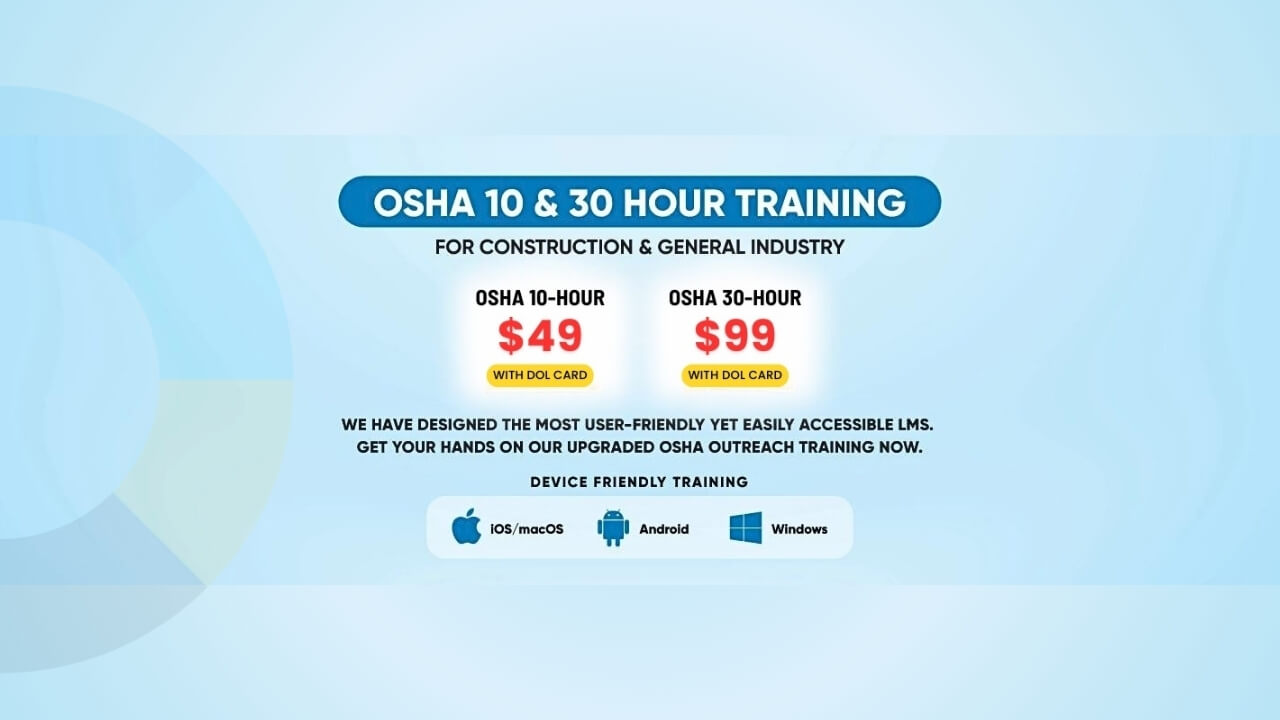OSHA Training Courses: Which Ones to Take?
The Occupational Safety and Health Administration (OSHA) training courses are essential for creating a safe and healthy working environment. However, knowing which OSHA courses to take can be overwhelming as an employee or employer. This comprehensive guide will help you navigate the options, understand the benefits, and determine the suitable courses for your needs.
Overview of OSHA Training Courses
OSHA training courses are designed to educate employers and employees on the recognition, avoidance, abatement, and prevention of safety and health hazards in the workplace. These courses fall into OSHA Outreach Training and OSHA Specialized Training.


OSHA Outreach Training
OSHA Outreach Training programs provide essential safety and health training for workers in various industries. They are divided into two levels:
OSHA 10-hour courses are designed for entry-level workers and cover general safety and health hazards. They are offered in four different versions:
- General Industry
- Construction
- Maritime
- Disaster Site Worker
OSHA 30-hour courses are designed for supervisors, managers, and other personnel responsible for enforcing safety regulations. They cover more in-depth information than the 10-hour courses and are offered in three different versions:
- General Industry
- Construction
- Maritime

OSHA Specialized Training
OSHA Specialized Training courses focus on specific topics, industries, or hazards. Some examples include:
- Hazardous Waste Operations and Emergency Response (HAZWOPER)
- Confined Space Entry
- Fall Protection
- Scaffolding Safety
- Lockout/Tagout
- Forklift Safety
- Electrical Safety
Choosing the Right OSHA Training Course
To determine which OSHA training course is right for you, consider the following factors:
Your Industry
Choose a course that is relevant to your industry. For example, construction workers should opt for OSHA 10-hour Construction or OSHA 30-hour Construction courses. Likewise, workers in manufacturing or warehousing should choose the General Industry version of the systems.
Your Job Role
Select a course based on your job role and responsibilities. For example, entry-level workers should start with OSHA 10-hour courses, while supervisors, managers, and safety personnel should consider OSHA 30-hour courses.
Regulatory Requirements
Some states and local jurisdictions have specific OSHA training requirements for certain job roles or industries. Check with your local regulatory agency to confirm which courses are mandatory.
Employer Requirements
Many employers require OSHA training as a condition of employment. Check with your employer or potential employer to determine their specific training requirements.
Benefits of OSHA Training Courses
Taking OSHA training courses can provide numerous benefits, such as:
Improved Workplace Safety
OSHA training courses equip workers with the knowledge and skills to identify, prevent, and address workplace hazards. This leads to a safer working environment and reduced risk of accidents and injuries.
Compliance with Regulations
OSHA training helps employers and employees comply with federal and state safety regulations. This can help prevent fines, penalties, and legal issues related to non-compliance.
Enhanced Employee Morale
Employees who feel confident in their ability to work safely are more likely to be satisfied with their jobs
and engaged in their work. This enhanced morale can lead to higher productivity and reduced employee turnover.
Reduced Workers’ Compensation Costs
By reducing workplace accidents and injuries, OSHA training can help lower workers’ compensation costs for employers. A safer workplace can also result in lower insurance premiums.
How to Take OSHA Training Courses
OSHA training courses can be taken in various formats, including:
In-person Training
In-person training courses are conducted by OSHA-authorized trainers at dedicated training centers or other locations. This format provides hands-on learning experiences and the opportunity to interact with instructors and fellow participants.
Online Training
Online training courses offer flexibility and convenience, allowing participants to complete the training at their own pace and from any location with internet access. OSHA-authorized providers deliver online courses and are ideal for those with busy schedules or limited access to in-person training.
On-site Training
On-site training is conducted by OSHA-authorized trainers at your workplace or a location of your choice. This format is ideal for organizations that need to train multiple employees at once, as it can be tailored to the specific needs and hazards of the workplace.
How many OSHA Classes are there?
When you take OSHA safety training in-person, the program is divided into several classes. However, in case of self-paced courses, the program is structured in modules. The 30-Hour programs can have 25-40 modules and 10-Hour programs can contain 10-15 modules depending on the authorized course creators.
If taken in-person, the 30-Hour OSHA training is typically completed over four to five in-person classes, depending on the training provider’s schedule. Many providers split the training into 6-hour sessions over five days or 7.5-hour sessions over four days to meet OSHA’s daily training limits.
Meanwhile, the 10-Hour OSHA training is typically completed over two in-person classes. Most providers split the training into 5-hour sessions over two days to comply with OSHA’s rule that no more than 7.5 hours of training can be conducted in a single day.
Types of OSHA Certifications
It is important to know that OSHA doesn’t directly issue any certification. Instead, it authorizes course creators to provide workplace safety training. The term OSHA certification is used for the certificate of completion for these courses. These are based on the levels of OSHA training.
- OSHA 10 Certification
- OSHA 30 Certification
- New York OSHA 10 Certification
- New York OSHA 30 Certification
Maintaining and Updating Your OSHA Training
OSHA training should be viewed as an ongoing process rather than a one-time event. To ensure that you remain knowledgeable about current safety practices and regulations, consider the following:
Refresher Courses
Regular refresher courses can help reinforce your knowledge and skills, ensuring that you prioritize workplace safety. Some OSHA courses, such as HAZWOPER, require annual refresher training.
Additional Specialized Training
As you progress in your career or take on new job responsibilities, you may need to complete additional specialized training courses. These courses can help you stay current with industry-specific safety standards and best practices.
Staying Informed
Keep yourself informed of changes to OSHA regulations and industry best practices by subscribing to newsletters, attending conferences, and participating in industry forums. Staying up-to-date with the latest information will help you maintain a safe and compliant workplace.
Conclusion
Choosing the right OSHA training course is crucial to ensuring a safe and healthy workplace. By considering your industry, job role, regulatory requirements, and employer requirements, you can select the most appropriate course for your needs. OSHA training helps create a safer working environment and can improve employee morale, reduce workers’ compensation costs, and comply with regulations. To stay current with safety practices and principles, consider taking refresher courses, enrolling in additional specialized training, and staying informed about industry updates.





